Metal Wall Panels: An Industry Perspective – Part I
By Marge O'Connor, DesignandBuildwithMetal.com
Editor's Note: Metal Wall Panels – Going From Simple To Spectacular is the first segment of a three-part article based on extensive interviews with industry executives representing the makers of single-element metal wall panel systems, insulated metal wall panel systems and metal composite material wall panel systems. To read Part II, titled Targeting Decision Makers, click here. To read Part III, titled What's Ahead For Metal Wall Panels, click here.
Metal Wall Panels – Going from Simple to Spectacular
From their early utilitarian use across America’s farmland to their visibility in today’s architectural masterpieces, metal wall panels have helped build structures and commerce for more than 40 years.
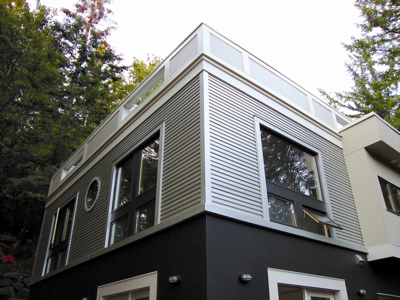 |
Metal wall panels from ATAS International are used
on this Portland, OR home as an architectural element that also offers long-term durability and low maintenance. Click image to enlarge. | |
The first designs were basic, and communication between suppliers and designers was fairly simple, with education being a key part of the sale. Today the entire process and the end result are much more sophisticated.
Designs are highly creative and vibrant. Metal wall panel products are innovative, there is a wider variety to choose from and they are designed to meet today’s high performance building needs. Marketing and communication is multi-layered and in
many cases instant. Education remains a huge part of marketing – but is quite comprehensive and delivered through a variety of media.
Design Trends
 |
Doug Pickens |
 |
Jim Bush |
Yes, the industry and its products have come a long way. “In the early years, metal wall panels were typically applied in a vertical manner. There was nothing exciting about these panels for them to compete against other products that were more
architecturally pleasing. Now designs are much more interesting. Metal panels are used in all kinds of directions, with multiple profiles placed on one wall. Single skins are combined with MCM, or different styles of panels are used to give a
design more definition,” says Jim Bush, vice president of sales for ATAS International, Allentown, PA.
The types of panels have grown from just one or two simple styles to a wide variety of different profiles, sizes, colors, metals, and gauges with a much broader spectrum of finishes and coatings.
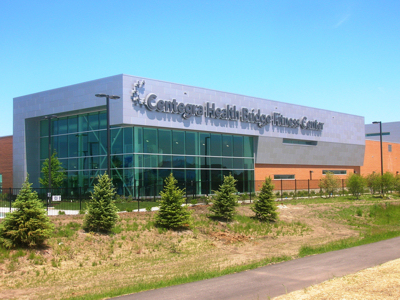 |
The running bond pattern on the 120,000 sq. ft. Centegra Health Bridge Fitness Center in Huntley, IL, creates a distinctive appearance by staggering the vertical joints between panels. This high-tech exterior was created with a computer-generated
random pattern using two different silver-colored insulated metal wall panels from Metl-Span.
Click images to enlarge. | |
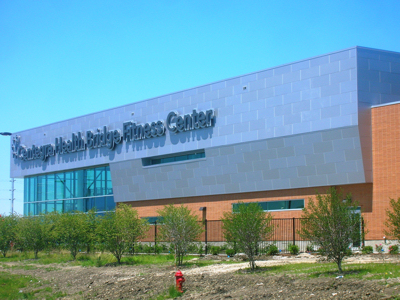 |
Applications have also expanded going from plain wall panels to unique architectural elements. Metal panels now clad entire building exteriors, frequently using one or several types of panels. They also are combined with other building materials, or applied
as a metal-on-metal accent.
“One project might use five or six different types of wall material along with glass. These designs mix and match two or three panel types, such as flat and profile, to impart a sense of texture on the exterior walls and improve the building’s
energy efficiency,” notes Doug Pickens, vice president of marketing for Metl-Span LLC, Lewisville, TX.
“Another new concept is to utilize trim components to accent the wall and do reveals to offset the metal panel system. This breaks up the wall cladding with metal accents and creates a whole new spectrum of ideas. The designs are also enhanced by
the variety of color options and flexibility of coatings that are now available for wall systems,” Bush adds.
Along with new panel types, the use of different metals has created more design opportunities. Aluminum composite material (ACM) was the first successful metal composite in the marketplace. But according to Brandon Wyatt, Marketing Manager, 3A Composites
USA (formerly Alcan Composites USA, Inc.), Charlotte, NC, the reference changed to the current metal composite material (MCM) as different types of metals began to be used for various panel applications. 3A Composites remains focused on
aluminum composite materials as its Alubobond product marks its 40th year in the market this year.
 |
Rick Brow |
 |
Brandon Wyatt |
“Designs are definitely more creative with metal since architects realize that it allows them more options for curves, vivid colors, transitional paints and colors that change in the sunlight, such as Alucobond Spectra which actually shifts in the
light. Depending upon the pigment type and viewing angle, different wavelengths of light are reflected back to the viewer resulting in an ever-changing color gradient with iridescent highlights,” Wyatt notes.
This transitional paint look is growing in popularity and has been used in children’s hospitals, the interior and exterior of retail clothing stores, and sports complexes where custom colors have been created to meet the vision of the architect
or designer.
 |
Jumer's Hotel & Casino in Rock Island, IL, includes a 170,000 sq. ft. casino and entertainment center connected to a five-story, 205-room hotel. Clad with panels fabricated from 3A Composites' Alucobond aluminum composite material, the casino flaunts flashing neon colors at night and lights up the landscape
with ever-changing color during the day, thanks to the metal panels' Alucobond Spectrapaint finish. Click images to enlarge. | |
 |
The market has also expanded for certain types of panels. In the last five years, for example, insulated metal panels (IMPs) have been chosen for all kinds of applications and a wider field of projects.
“Historically, IMPs have been used for cold storage applications, warehouses, freezers, coolers and food processing facilities. Now their use is more broad-based because they can fit the needs of any non-residential structure. They are also ideal
for retrofit applications,” says Pickens, noting that the type of IMP used does not limit the design.
“New patterns that use IMPs with other panels are extremely creative. They are being used in more horizontal applications than ever before. The running bond pattern is particularly popular. It looks like staggered vertical joints and can combine
different colors or shades of a single color scheme,” he adds.
Market Evolution
Creativity is not the only factor affecting designs. Other influences include new technology for design, manufacturing, testing and marketing; more stringent energy codes; the national push for more energy efficient buildings; results from ongoing product
testing and technical research; and increased marketing by competing materials providers.
 |
Ken Buchinger |
Changing codes and standards have affected the entire design and build process in the last several years and will continue to do so. Rick Brow, director of marketing for CENTRIA, Moon Township, PA, notes: “Decisions today are heavily influenced
by energy codes. Additional insulation in exterior walls and roofs is required and additional thermal requirements are expected in future codes. The trend to move insulation outside of the metal stud cavity has also resulted in a variety of new products/solutions.”
Brow also notes that certain changes in codes have helped improve the market for wall panels. “We’re getting away from the true barrier wall, and using more rainscreen techniques, where walls are back ventilated or pressure equalized. This
has allowed metal panels to be used in more projects.”
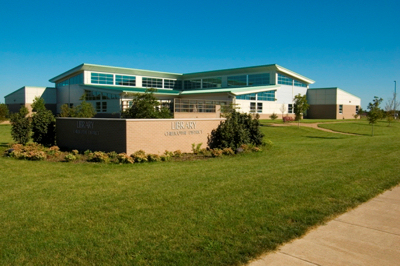 |
The library in Chillicothe, IL features a mix of ribbed and flat concealed fastener wall panels from CENTRIA.
In addition to good looks, the panels offer long-term durability. Click images to enlarge. | |
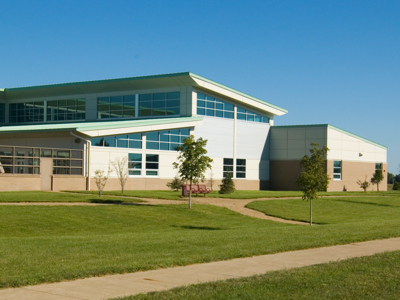 |
The metal industry also has increasingly used technology to meet specific needs and to produce better products.
“The design community is reinventing the use of metal panels. We have had jobs where architects wanted something unique and each time we were able to custom produce it. From a manufacturing point we now have more flexibility to produce custom panels;
current technology makes it a lot easier. This ability also makes metal more competitive from a design standpoint because the design can be more flexible without adding a lot of cost to the wall assembly,” says Bush.
The depth of the research produced by the metal industry also has helped expand the market by showing how metal performs in a variety of situations.
“Metal is probably the most tested and well understood construction material there is because of what our industry has done in testing and research. We fully understand how metal reacts in extreme weather conditions, such as high wind, rain, and
hail; in seismic zones; and, how it reacts thermally in hot and cold climates. Because of all this research, architects can be assured that there are metal products that will perform well in most environmental applications. This testing and overall
product performance is critical to ensuring that the building performs as the architect intended during design,” says Ken Buchinger, vice president of business development and research and development for MBCI, Houston.
The testing also has increased the understanding of the types of products and proper installation details to use in given applications, which also aids metal panel installers and fabricators, who play a key role in achieving the ideal outcome on a project.
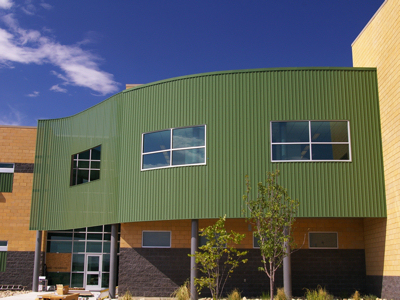 |
Dark green wall panels from MBCI complement the brick
and glass elements of the new Davis Junior High in Layton, UT. Click images to enlarge. | |
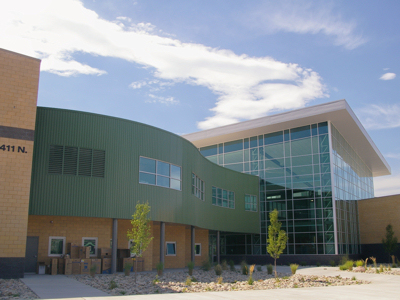 |
As the market has matured, new opportunities also have surfaced for metal panels. In the last 12 years, environmental needs have become one of the strongest issues for the construction industry, and the green building movement has been positive for
the role of metal wall panels in building design.
“A number of criteria affect the overall design of the building envelope, including the architect’s vision, the building owner’s needs, zoning laws, energy codes and the architectural look of other buildings in the vicinity. As energy
codes become more stringent, architects are being required to design building envelopes that are much more efficient. For better building performance, they’re looking at IMPs as an effective solution while giving the building a great looking
exterior. As the energy efficiency of building envelopes becomes a greater priority, the market for insulated wall panels will get even bigger,” Buchinger says.
About four years ago the growing emphasis on sustainability and a building’s long-term energy efficiency began to increase the demand for IMPs and change their market position. “This also reversed the perception that IMPs were expensive
when compared to other construction materials. Now, designers and owners who once thought IMPs were too expensive are realizing their value in reducing operating costs. As energy expenses increase and more companies and organizations become environmentally
sensitive, IMPs are increasingly being used,” Pickens says.
These product advances and market shifts also present challenges in reaching decision makers.
Editor's Note: Our second installment, “Targeting Decision Makers,” covers the trends and opportunities in marketing metal wall panels. To read it, click here.
For hotlinks to the websites of the companies mentioned in this article, as well as dozens of other leading manufacturers of metal wall panel systems, please visit the Metal Wall Panels section of our Manufacturers & Suppliers Directory here. By using the directory's category search feature you can see makers broken out according to 13 different metal wall segments.